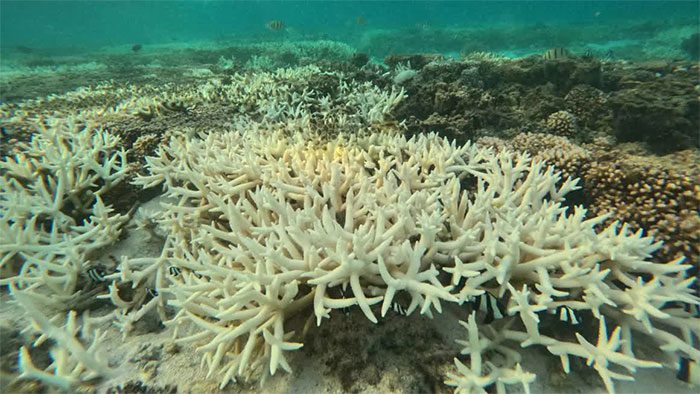Some experts warn that this could become the worst coral bleaching period in recorded history.
“More than 54% of the world’s coral reefs have experienced bleaching in the past year, affecting at least 53 countries and territories, including vast areas in the Atlantic, Pacific, and Indian Oceans,” stated a joint declaration from the National Oceanic and Atmospheric Administration (NOAA) and the International Coral Reef Initiative (ICRI).
Ecologist Derek Manzello, coordinator of NOAA’s coral reef monitoring agency, which oversees global coral bleaching risks, noted that this phenomenon is likely to soon surpass the previous peak of 56.1%. The rate of coral reef areas experiencing bleaching has increased by about 1% per week.

Coral bleaching phenomenon at Lady Elliot Island of the Great Barrier Reef on February 19, 2024. Photo: Rebecca Wright / CNN
When corals are under stress from marine heatwaves, they expel the living algae within their tissues. If ocean temperatures do not return to normal, bleaching can lead to massive coral die-off, threatening the collapse of species and food chains that depend on them.
This marks the fourth global bleaching event in history and the second in the past decade – following previous events in 1998, 2010, and between 2014-2017.
In the past year, mass bleaching events have been confirmed in regions including Florida and the broader Caribbean, Mexico, Brazil, Australia, the South Pacific, the Red Sea, the Persian Gulf, Indonesia, and the Indian Ocean, including the eastern coast of Africa and Seychelles.
Professor Ove Hoegh-Guldberg, a climate scientist specializing in coral reefs based at the University of Queensland in Australia, predicted this mass bleaching event months in advance.
“We know that sea temperatures are rising rapidly, but not at this rate. The concerning issue is that we cannot predict how long this significant temperature change might last,” Hoegh-Guldberg said.
The past 12 months have been recorded as the hottest on the planet, with ocean temperatures soaring. According to data from the Copernicus Climate Change Service of the European Commission, global sea surface temperatures reached record highs in February and again in March.
In February, scientists at NOAA’s coral reef monitoring program added three new warning levels to the coral bleaching alert map, helping scientists assess the new scale of underwater warming.
The La Niña Phenomenon
La Niña refers to the phenomenon of cooler-than-normal sea surface temperatures in the central and eastern equatorial Pacific.
El Niño, a natural climate pattern originating from the Pacific along the equator that tends to raise global temperatures, has contributed to unprecedented ocean temperature increases.
NOAA predicts that La Niña could return between June and August this year, bringing an “glimmer of hope” for coral reefs. However, bleaching has still occurred during La Niña events in recent years.
In mid-February this year, widespread coral bleaching occurred at the Great Barrier Reef in Australia – the world’s largest coral reef system – across five different reefs throughout the northern and southern regions.
The mass bleaching event was officially confirmed last month following aerial and underwater surveys by the Australian Institute of Marine Science (AIMS) and the Great Barrier Reef Marine Park Authority.
Selina Stead, CEO of AIMS, noted the increasing frequency and intensity of marine heatwaves due to climate change, which are testing the resilience of coral reefs. Climate change is the greatest threat to coral reefs globally, and this global confirmation highlights the widespread impact over the past 12 months.
“That is why the world must strive to reduce carbon emissions. It is also crucial to ensure that coral reefs are well managed at local and regional levels,” Stead added.
The United Nations Environment Programme has warned that if the world does not actively reduce emissions, the planet could warm by nearly 3 degrees Celsius compared to pre-industrial levels this century.
Scientists also warn that if temperatures rise by 2 degrees – a level the world could reach around 2050 – approximately 99% of corals on Earth will die.
In addition to being essential habitats for marine life, coral reefs are crucial for coastal communities around the world. They serve as a vital defense system against flood threats from storms and rising sea levels while providing livelihoods and essential food sources for marine species for about one billion people globally.
David Ritter, CEO of Greenpeace Australia, emphasized that coral reefs are facing “an imminent danger,” with the direct cause attributed to fossil fuel companies and governments supporting this industry.
“We are running out of runway to avoid climate disaster and must act quickly to ensure an immediate end to new fossil fuel use,” Ritter added.


















































